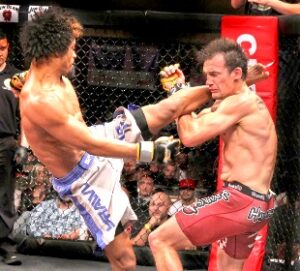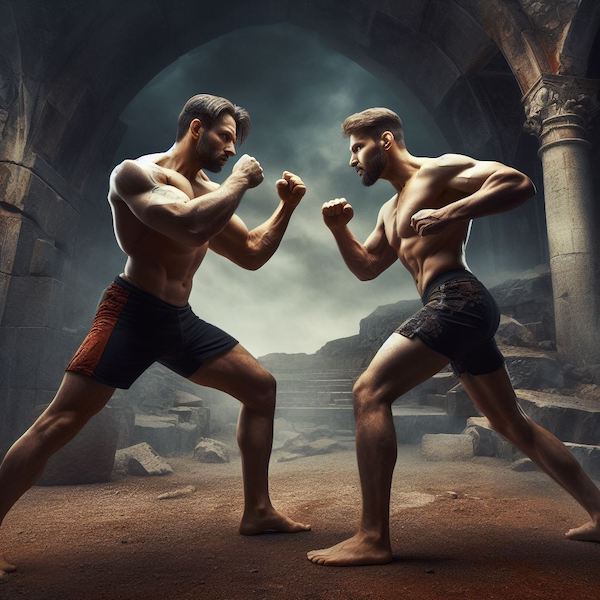
Are you wondering how pankration and MMA differ?
In this article, we’ll examine the differences between ancient pankration and MMA, as well as modern pankration and MMA.
Note: you can use the contents table to quickly see the differences.
Ancient Pankration vs MMA
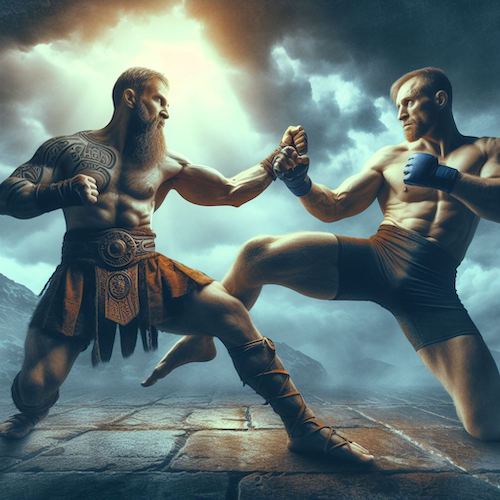
In short, the main differences between ancient pankration and MMA are that pankratiasts could fight to the death (highly brutal), they relied on wrestling skills, they fought without protective gear and were most often naked, and men fought for pride, status, and in honor of the Greek gods.
However, there are 10 main differences between ancient pankration and MMA. Let’s take a look at each.
1. History
Ancient Pankration: has its roots in Ancient Greece, where it was introduced in the Olympic Games of 648 BC.
MMA: has its roots in 1920s Brazil with vale tudo, with the first MMA promotion being Shooto in 1989.
The founding of the UFC followed this in 1993, when the term mixed martial arts was first coined.
2. Purpose
Ancient Pankration: was created as a sport for the ancient Olympic Games, which had religious significance as they were held in honor of the Greek god Zeus.
It was also a way to train soldiers in hand-to-hand combat and to celebrate physical fitness, courage, and the Greek ideal of arete (virtue or excellence).
The sport wasn’t commercialized and was more about personal and city-state honor and prestige. For many, winning was also considered a form of divine favor with the gods.
For men in Ancient Greece, pankration was a way to demonstrate physical prowess and honor, contributing to their status in society.
Some could go on to join the ruler’s circle, as Dioxippus did with Alexander the Great.
MMA: was developed, particularly the UFC, with the intention of finding the most effective martial art by pitting them against one another in a contest with minimal rules.
However, while this was the unique selling point of the UFC, all MMA promotions are founded for the purpose of profit-making – as are most businesses.
At the same time, MMA athletes are professional sportspeople who often seek fame and financial success through fighting.
Many are also fighting for championships and becoming the best, but this is usually a byproduct.
3. Rules and Regulations
Ancient Pankration: had only 2 rules, no biting or eye-gouging. Everything else was fair game.
MMA: has a comprehensive set of rules, including weight classes, rounds, time limits, and prohibited techniques like headbutting, groin striking, and striking the back of the head (rabbit punches).
4. Fighting Styles, Techniques, and Skill
Ancient Pankration: had very few rules, which meant competitors were using brutal means to win in any way necessary.
They were aiming to hurt their opponent to make them quit. If their opponent wouldn’t quit, they could win via death.
Some examples of brutal techniques used include:
- Bending the opponent’s fingers
- Direct throat strangulation and digging fingers (Tracheal grip choke)
- Strikes to the groin, throat, and spine
- Stomping a downed opponent
- Headbutts
- Breaking an opponent’s bones and continuing the fight
- Slamming or smashing an opponent’s head against the ground
Also, as boxing and wrestling were the main martial arts of the time, most pankratiasts were skilled grapplers who were ineffective with leg strikes and striking in general.
This meant wrestling was the main fighting style used and most fights were decided by getting the opponent to the ground and applying chokes and joint locks.
Knockouts were less common and deaths were rare, but they were allowed.
It also meant pankratiasts who were skilled with kicking techniques had a major advantage and would most often win against their more predictable opponent.
MMA: fighters are extremely skilled and well-rounded as popularity and competition increase.
It’s also because MMA fighters know the importance of becoming highly skilled in a striking martial art like kickboxing or Muay Thai, a wrestling art for control, and Brazilian jiu-jitsu for submissions.
Overall, MMA fighters in the top MMA promotions are leaps and bounds above ancient pankratiasts in skill level and well-roundedness. Pankratiasts mostly relied on wrestling skills.
5. Safety and Medical Attention
Ancient Pankration: was known for its brutality, and there was little to no immediate medical attention for injuries.
In ancient Greece, the concept of sports medicine was non-existent, and the understanding of how to treat injuries was rudimentary compared to contemporary standards.
While there may have been some basic forms of care — such as the use of bandages, splints, and some herbal remedies — the medical knowledge and resources available were limited.
Care would have been administered on-site or at the athlete’s home. For long-term recovery, the athlete would have relied on the support of family, friends, or their patron.
MMA: has medical staff on hand and fighter safety is a top priority with immediate medical attention or hospital transport available.
MMA also has ringside doctors who can inspect a fighter mid-round upon the request of the referee.
Ringside doctors have the power to end the fight if they believe an injury is serious and is likely to become worse if the fight were to continue. They have the fighter’s best interest in mind.
If fighters are badly injured, they can spend as long as they need to fully recover. This may be a year or two years if needed.
6. Protective Gear
Ancient Pankration: pankratiasts didn’t wear any protective gear and most often competed naked.
MMA: Fighters wear 4-ounce gloves over hand wraps, mouthguards, cups, and shorts. Female MMA fighters also wear a shirt and amateurs wear additional protective gear like headguards.
7. Method of Victory
Ancient Pankration: fighters could win via knockout, submission, forfeit, and death. Fighters could forfeit or submit by raising their index finger.
MMA: fighters can win via knockout, submission, judge’s decision via scorecards, opponent disqualification, or forfeit. Fighters can submit to submissions and strikes by tapping or verbal communication.
8. Training
Ancient Pankration: training was integrated into the fabric of Greek society and aimed at creating a versatile, physically capable individual ready for both athletic competition and warfare.
However, at this point in time, there was an absence of sports science which meant pankratiasts had no idea about nutrition, injury prevention, and recovery techniques.
Many pankratiasts were part-time athletes.
MMA: training is a highly specialized, multidisciplinary, and scientific endeavor designed to prepare fighters to compete against equally skilled opponents at the highest level imaginable.
Many MMA fighters are genetic specimens who’ve trained for most of their life (at least 15+ years), have several coaches, and are further enhanced by steroids and other performance-enhancing drugs.
9. Gender and Age Participation
Ancient Pankration: was exclusively for male participants. Initially, it was only for men but boys (under 18) started competing at the Olympic Games in 200 BC.
MMA: includes both male and female fighters with a growing emphasis on women’s competition. MMA Fighters must be 18 years old.
A rare few can compete before the age of 18 if they’re highly skilled, experienced, and have an approved license from a State Athletic Commission.
10. Fight Arena
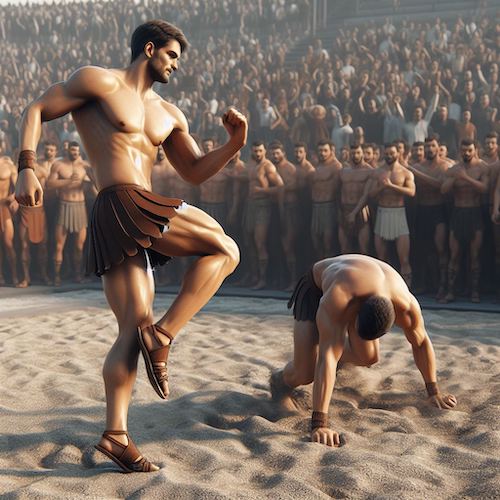
Ancient Pankration: was contested on soft earth or sand in open-air arenas, which provided a natural, forgiving surface suitable for the intense combat of the sport.
The fight arenas were simple and functional, with a designated area for the combatants that was usually flat and marked by boundaries.
Since the events were held outdoors, competitors had to contend with the elements such as rain or the position of the sun.
MMA: bouts take place on padded canvases within rings, cages, or octagons. These indoor venues are designed to protect fighters from the elements and ensure a consistent fighting environment for all competitors.
Modern Pankration vs MMA
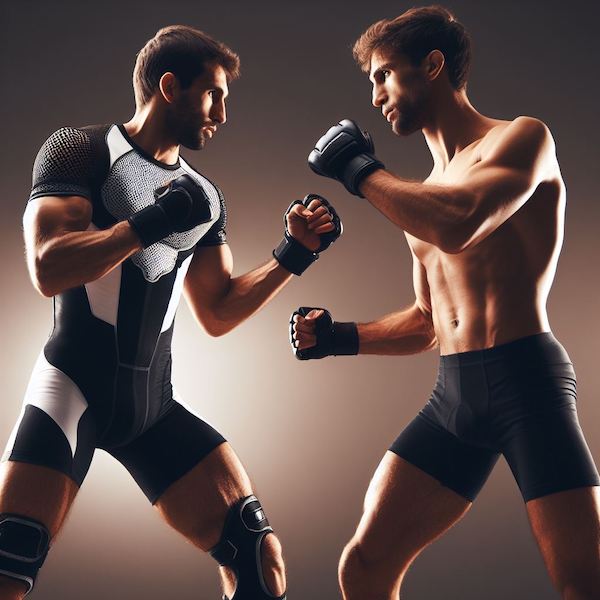
In short, the main differences between modern pankration and MMA are that modern pankration has many more illegal techniques that stifle the fight, it uses a point scoring system, knockdowns stop the fight (like in boxing), the competition area is a wrestling mat, and fighters must wear rash guards, shorts, and shin guards.
However, there are 10 main differences between modern pankration and MMA. Let’s take a look at each.
As many of the differences between ancient pankration and MMA revealed much about MMA, MMA differences will only be listed below if there’s new information to be presented.
1. Rules (Illegal Techniques)
Modern pankration has many more rules than MMA, meaning pankration has become a strange shadow of its former self and can be considered a watered-down version of MMA.
Since 2010, under the governance of United World Wrestling (UWW), pankration has been governed by rules that prioritize safety.
UWW also oversees Olympic wrestling, which is where the focus on safety comes from.
Competition events under UWW are split into two main rulesets that have slight differences throughout. They are:
- Pankration Traditional – bout without punches to the head
- Pankration Elite – bout with limited punches to the head
Here are some of the main rules modern pankration follows, as per the International Pankration Regulations (2016).
The following are all banned:
- Weight cutting
- Targeting joints
- Punches to the head (pankration traditional only)
- Targeting kidneys
- Targeting the knees and below
- Strikes on the ground
- Knees to the head
- Hammer fists
- Elbows to the head or from above
- Intentional breaking of bones or joints
- Slams in defense of submission attempts
- Slams at any level from a standing position
- Twisted head, neck, and leg locks
- Inside or outside heel hooks
- Crucifix, Full-Nelson, Can opener / Neck crank
There are more illegal techniques than this, but these are all of the illegal techniques in modern pankration that are completely legal in MMA.
2. Scoring System
Modern Pankration: has a point-scoring system similar to taekwondo and karate.
Traditional Pankration Scoring
1-point techniques
- Effective and authorized punch to the body
- Effective and authorized outside kick to the thigh
- Takedown
2-point techniques
- Side Mount
- Effective and authorized kick or knee to the body
- Half or low amplitude throw from standing or ground position (with the opponent not passing over the
- thrower’s body)
3-point technique
- Full Mount
- Complete or high amplitude throw from a standing position (with the opponent passing over the
- thrower’s body)
- Effective and authorized kick to the head (light contact)
4-point technique
- Back Mount
- Knockdown
Elite Pankration
While both Traditional and Elite Pankration reward points for body punches, thigh kicks, takedowns, and various mounts, Elite Pankration uniquely assigns points for head punches and kicks while competitors are standing.
This encourages a more dynamic and upright engagement. Additionally, in Elite Pankration, techniques that demonstrate clear control and significant impact, such as high amplitude throws and knockdowns, are highly valued, reflecting the elevated skill level expected at this tier of competition.
Overall, the scoring system in Elite Pankration is designed to foster a more versatile and comprehensive display of martial prowess.
Pankration Scoring Visibility
Each score is displayed to spectators, competitors, and coaches throughout the match using an electronic scoreboard.
All officially approved competitions utilize the electronic scoring system established by UWW.
This system ensures impartiality in scoring as it requires a consensus among all referees, rather than relying on the judgment of a single official.
MMA: uses the 10-point must system, and if the match makes it to the end of time, only then are the judge’s scorecards revealed.
Under this system, 10 points must be given to the fighter who wins the round, and nine points or less to the loser.
This means it’s possible for a fighter to win a round by scoring 10-9, 10-8, and even 10-7.
The scores of each round are tallied and revealed if required for an early decision result, or if the fight reaches the end of the last round.
3. Method of Victory
Modern Pankration: fighters can win via:
- Submission
- Knockout
- Outscoring the opponent
- Disqualification
- Forfeit
- Default – when a fighter is unable to continue for any reason
- Technical superiority – when a competitor scores 12 points without the opponent scoring
- 2 knockdowns in a match is an automatic win
- If points are tied at the end of time, there’s a 1 minute overtime. If the score is tied again, the last fighter to score wins the match.
4. Knockdowns
Modern Pankration: if an opponent is knocked down, the match is stopped. There’s then a 10-second count to see if the fighter is able to resume. If unable to resume, the opponent is declared the winner.
MMA: if an opponent is knocked down, the standing fighter can choose to follow their opponent to the ground or have the referee stand them up.
If they follow them to the ground, they can control them, land ground strikes, and attempt submissions.
5. Point Deductions & Disqualifications
Modern Pankration: illegal actions result in 1 point awarded to the opponent. The third offense results in disqualification.
MMA: illegal actions result in 1 point being deducted from the offender. Fighters are disqualified if they commit an illegal action that renders their opponent unable to continue.
6. Competition Area
Modern Pankration: pankration events under UWW take place on UWW-certified mats measuring either 10×10 or 12×12, marked with a circle ranging from 8 to 10 meters in diameter.

At the heart of the mat, there’s a 1-meter circle designated as the initial position for the competitors.
Surrounding the outer perimeter of this circle, there’s a safety margin of at least 2 meters.
Pankratiasts can be out of bounds while standing if pushed out of the area with both feet.
On the ground, being out of bounds is defined by the competitor’s entire body moving past the protective zone.
In such instances, the referee will halt the action and reset the competitors to a neutral standing stance.
MMA: fighters can’t be out of bounds because they’re fighting in a cage, ring, or octagon.
While there isn’t a set size for any, the UFC’s octagon comes in 2 sizes: 30 feet across (9.1m) and 25 feet across (7.6m).
7. Bout Duration
Modern Pankration bouts last:
- Matches for novices and school-aged boys and girls have a duration of 2 minutes (12-15).
- Matches for cadets are 3 minutes (16-17).
- Matches for juniors and veterans are 4 minutes (18-20).
- Matches for seniors are 5 minutes (20+).
- Matches for Polydamas (team demonstration event) showcases are between 1 and 2 minutes.
MMA bouts last:
- 3 rounds of 5 minutes each for normal fights
- 5 rounds of 5 minutes each for title fights
8. Attire
Modern Pankration:
- Fighters must wear a red/blue rashguard and black shorts.
- The rashguards must be form-fitting with short sleeves and predominantly (at least 70%) the designated color.
- Rashguards combining red and blue aren’t permitted.
- The shorts should be black and may feature a meander pattern on any section.
- The shorts must fit appropriately without being overly loose and should not include pockets, buttons, or snaps that could pose a risk during the match.
- Wearing compression shorts or pants beneath the board shorts isn’t allowed.
9. Protective Gear
Modern Pankration:
Traditional Pankration
- a) Gloves must be at least 4 ounces, available in red or blue.
- b) Protective gear for the groin area is required.
- c) Shin guards should be in red or blue and made of neoprene with a foam padding of 1-centimeter thickness.
- d) A mouthpiece is mandatory.
- e) Women may choose to wear chest protection.
Elite Pankration
- a) Gloves, provided in red or blue, must weigh a minimum of 6 ounces.
- b) Groin protection is compulsory.
- c) Shin guards (neoprene) are required in red or blue.
- d) A headguard is necessary and must be made of high-quality leather, such as cowhide or Grade-A leather. It must contain a single-piece injected foam padding of 1 centimetre thickness
- e) A mouthpiece must be worn.
- f) Chest protection is optional for women.
10. Origins
Modern Pankration: traces its revival back to before 2010, but it was in that year when the sport took a significant leap forward.
Recognized by FILA (now United World Wrestling, UWW), the body that oversees Olympic wrestling, pankration was endorsed as an associate discipline of MMA.
This endorsement was a nod to the sport’s historical roots and its evolution into a contemporary combat sport.
The same year, pankration made its debut at the World Combat Games, marking its place on the international stage and signaling a new era for this ancient sport.
The Bottom Line
Ancient pankration was a lot more brutal than modern MMA in 2023, while modern pankration is a shadow of its former self.
It’s a completely watered-down version of MMA, with many more illegal techniques and completely different rules regarding scoring, knockdowns, point deductions, competition area, bout duration, attire, and more.
Overall, while modern pankration is considered an associate discipline of MMA, they’re completely different martial arts.
Modern pankration is safe, restrictive, and soft, while MMA is dynamic, exciting, and dangerous – with fighters putting their reputation and brain and body health on the line every time they fight.




